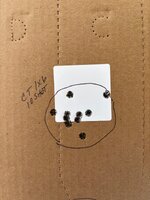RWT
WKR
- Joined
- Jul 4, 2022
- Messages
- 957
Crimson Trace hardline 1-6x24 34MM SFP drop test
After @Formidilosus tested my CT 4x16 SFP and it appeared to perform "decent", but then the FFP model failed terribly. I thought why not try a SFP model to replace some of my old muzzle loader scopes and potentially my truck gun scope. Besides the majority of the hunting market is Fudd's with SFP's for under 300 yard shots. I have enough Mavens & S&B's and my Fudd buddies will not spend that level of engineering. I recommend the Trij Accupoint and they still scream Leupold and Vortex rule. I am also thinking I want a fixed 7 with good glass and an illuminated reticle for hog hunting or potential thermal clip on in the future. As none of the manufactures make a fixed 6, 7, or 8 power with illuminated reticles maybe a LPVO would work in a 1-6 configuration. If I want to dial the max magnification would have the wind holds accurate and I have found 6X is almost perfect for my hunting ability to 300 yards on hog size game.
*Side note- I assume a fixed power scope is a FFP as there is only one focal plane?
So I picked up a used CT Hardline 1-6x24 34mm on the forum. The seller contended it was new in box. The price was right and I needed to see if the scope would hold zero or suffer any low light challenges. I am not a good enough shot or have enough experience to judge wind holds or reticle accuracy. I leave that up to those who know what they are doing. However, given this is the internet; I have a public school education and a laptop, I am instantly an expert......................
Short drop review: Rifle is a 6.5 Grendel g1 ruger american ranch I picked up in a trade. The action is Locktite 380'd into a Bravo chassis and the warne rail is LT 380's to the action. I didn't have any good 34mm rings but found a pair of Monstrum's for under $40 and thought I would give them a try. I expected the rings to be the weakest point and will replace them if I decide to keep the scope. Rifle has a SWFA 10X Mil in Warner MT rings as the control system. I have dropped tested this set up previously and had no shift in zero. I have also tested a NF SHV in this set up with no shift in zero. I can't see or shoot worth a darn, but at least my set up cannot be blamed. All bad groups are 100% ME. This rifle on its best day would shoot a 1.3" 10 shot group. Norm's are 1.5-2". PIC of 2.2" group.


Swapped from the SWFA to the CT. I previously cleaned and vibratited the rings on to another rifle at the house, so all I needed to do was swap it over. The rings were installed with a Fix it wrench to 30lbs base and 25lp tops. PICS of rings
Sighted in on 6X and proceeded with 10 shot group of 1.8". Amazingly this 10 shot group was better than the SWFA. I believe it is due to the reticle. I have trouble seeing the SWFA MIL reticle. The SWFA MOA reticle actually has a floating dot and I shoot it better than the MIL. Why this is, I don't know, but it leads me to giving more credence to "reticles matter". This is especially true for those of us with poor eyesight and who suck at shooting. PIC of 10 shot group with caliper
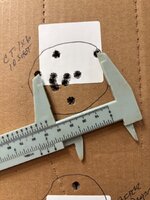
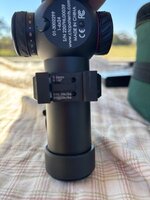
Now to the drop portion test. Media is the same 3/4 shop mats I've used previously. I don't have any grass due to lack of rain and fat cows. I used 2 bags of deer corn as the base with the mats on top. I decided to forgo the 18' portion and proceeded directly to 36" from start. (I do have concerns on the corn as a base being to soft?) Shots are as marked. If the zero jumped on the first 36" then I was not going to continue and waste ammo, unless there was a ring failure.
C= confirm zero
1= rt 36"
2=top 36"
3=left 36"
4=3 drops rt 36"
5=3 drops top 36'
6= 3 drops left 36"
All drops appeared to stay in the cone. The cone was exactly the same as the 10 shot group.
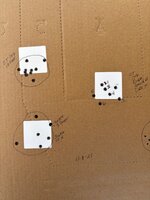

I would consider this to be "decent". So what does "decent" mean? As I've followed the evals for few years now I see them as a representation of % of failure rate over time. The eval accelerates the time. Everything has a useful life span. Some company's scopes are engineered and QC tested to have a lower % of failure and longer useful life before a failure. The scopes that pass the full eval generally have the fewest failures and the longest useful life. NF & SWFA for instance. I call these PASSED. The scopes that fail a portion appear to fail sooner, thereby they have a shorter useful life span. Consider the Arken EP's- passed the drop test but failed to hold zero riding in the truck. This qualifies as decent- I have some faith in it but know I need to continuously verify zero as it will likely fail in my lifetime.
I will likely keep this scope as it checks numerous boxes and qualifies for me as 'decent".
"SHOULD' hold zero for some time, but will require periodic checks- at least I get to shoot more
Mil reticle with floating dot so I can see it
Wind calls should be accurate if I need them at a magnification that does not limit FOV
Should be able to use reticle for quick drop instead of dialing - need to physically verify to be certain
Illuminated reticle for hunting hogs over green lights on feeders
Glass and objective size are not a limiting factor for low light so far- need to verify to be certain
Price point is very agreeable for the use case
At least those who were considering picking up a CT Hardline for a set and forget for their kids have some more data. I can also tell my FUDD friends this model likely won't fail immediately like a Vortex.
If a manufacturer makes a 6,7,8 X fixed, MIL floating dot reticle with illumination, I'll move this to a 22 in a minute.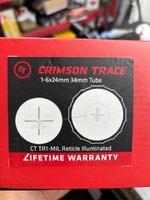

After @Formidilosus tested my CT 4x16 SFP and it appeared to perform "decent", but then the FFP model failed terribly. I thought why not try a SFP model to replace some of my old muzzle loader scopes and potentially my truck gun scope. Besides the majority of the hunting market is Fudd's with SFP's for under 300 yard shots. I have enough Mavens & S&B's and my Fudd buddies will not spend that level of engineering. I recommend the Trij Accupoint and they still scream Leupold and Vortex rule. I am also thinking I want a fixed 7 with good glass and an illuminated reticle for hog hunting or potential thermal clip on in the future. As none of the manufactures make a fixed 6, 7, or 8 power with illuminated reticles maybe a LPVO would work in a 1-6 configuration. If I want to dial the max magnification would have the wind holds accurate and I have found 6X is almost perfect for my hunting ability to 300 yards on hog size game.
*Side note- I assume a fixed power scope is a FFP as there is only one focal plane?
So I picked up a used CT Hardline 1-6x24 34mm on the forum. The seller contended it was new in box. The price was right and I needed to see if the scope would hold zero or suffer any low light challenges. I am not a good enough shot or have enough experience to judge wind holds or reticle accuracy. I leave that up to those who know what they are doing. However, given this is the internet; I have a public school education and a laptop, I am instantly an expert......................
Short drop review: Rifle is a 6.5 Grendel g1 ruger american ranch I picked up in a trade. The action is Locktite 380'd into a Bravo chassis and the warne rail is LT 380's to the action. I didn't have any good 34mm rings but found a pair of Monstrum's for under $40 and thought I would give them a try. I expected the rings to be the weakest point and will replace them if I decide to keep the scope. Rifle has a SWFA 10X Mil in Warner MT rings as the control system. I have dropped tested this set up previously and had no shift in zero. I have also tested a NF SHV in this set up with no shift in zero. I can't see or shoot worth a darn, but at least my set up cannot be blamed. All bad groups are 100% ME. This rifle on its best day would shoot a 1.3" 10 shot group. Norm's are 1.5-2". PIC of 2.2" group.


Swapped from the SWFA to the CT. I previously cleaned and vibratited the rings on to another rifle at the house, so all I needed to do was swap it over. The rings were installed with a Fix it wrench to 30lbs base and 25lp tops. PICS of rings
Sighted in on 6X and proceeded with 10 shot group of 1.8". Amazingly this 10 shot group was better than the SWFA. I believe it is due to the reticle. I have trouble seeing the SWFA MIL reticle. The SWFA MOA reticle actually has a floating dot and I shoot it better than the MIL. Why this is, I don't know, but it leads me to giving more credence to "reticles matter". This is especially true for those of us with poor eyesight and who suck at shooting. PIC of 10 shot group with caliper


Now to the drop portion test. Media is the same 3/4 shop mats I've used previously. I don't have any grass due to lack of rain and fat cows. I used 2 bags of deer corn as the base with the mats on top. I decided to forgo the 18' portion and proceeded directly to 36" from start. (I do have concerns on the corn as a base being to soft?) Shots are as marked. If the zero jumped on the first 36" then I was not going to continue and waste ammo, unless there was a ring failure.
C= confirm zero
1= rt 36"
2=top 36"
3=left 36"
4=3 drops rt 36"
5=3 drops top 36'
6= 3 drops left 36"
All drops appeared to stay in the cone. The cone was exactly the same as the 10 shot group.


I would consider this to be "decent". So what does "decent" mean? As I've followed the evals for few years now I see them as a representation of % of failure rate over time. The eval accelerates the time. Everything has a useful life span. Some company's scopes are engineered and QC tested to have a lower % of failure and longer useful life before a failure. The scopes that pass the full eval generally have the fewest failures and the longest useful life. NF & SWFA for instance. I call these PASSED. The scopes that fail a portion appear to fail sooner, thereby they have a shorter useful life span. Consider the Arken EP's- passed the drop test but failed to hold zero riding in the truck. This qualifies as decent- I have some faith in it but know I need to continuously verify zero as it will likely fail in my lifetime.
I will likely keep this scope as it checks numerous boxes and qualifies for me as 'decent".
"SHOULD' hold zero for some time, but will require periodic checks- at least I get to shoot more
Mil reticle with floating dot so I can see it
Wind calls should be accurate if I need them at a magnification that does not limit FOV
Should be able to use reticle for quick drop instead of dialing - need to physically verify to be certain
Illuminated reticle for hunting hogs over green lights on feeders
Glass and objective size are not a limiting factor for low light so far- need to verify to be certain
Price point is very agreeable for the use case
At least those who were considering picking up a CT Hardline for a set and forget for their kids have some more data. I can also tell my FUDD friends this model likely won't fail immediately like a Vortex.
If a manufacturer makes a 6,7,8 X fixed, MIL floating dot reticle with illumination, I'll move this to a 22 in a minute.



